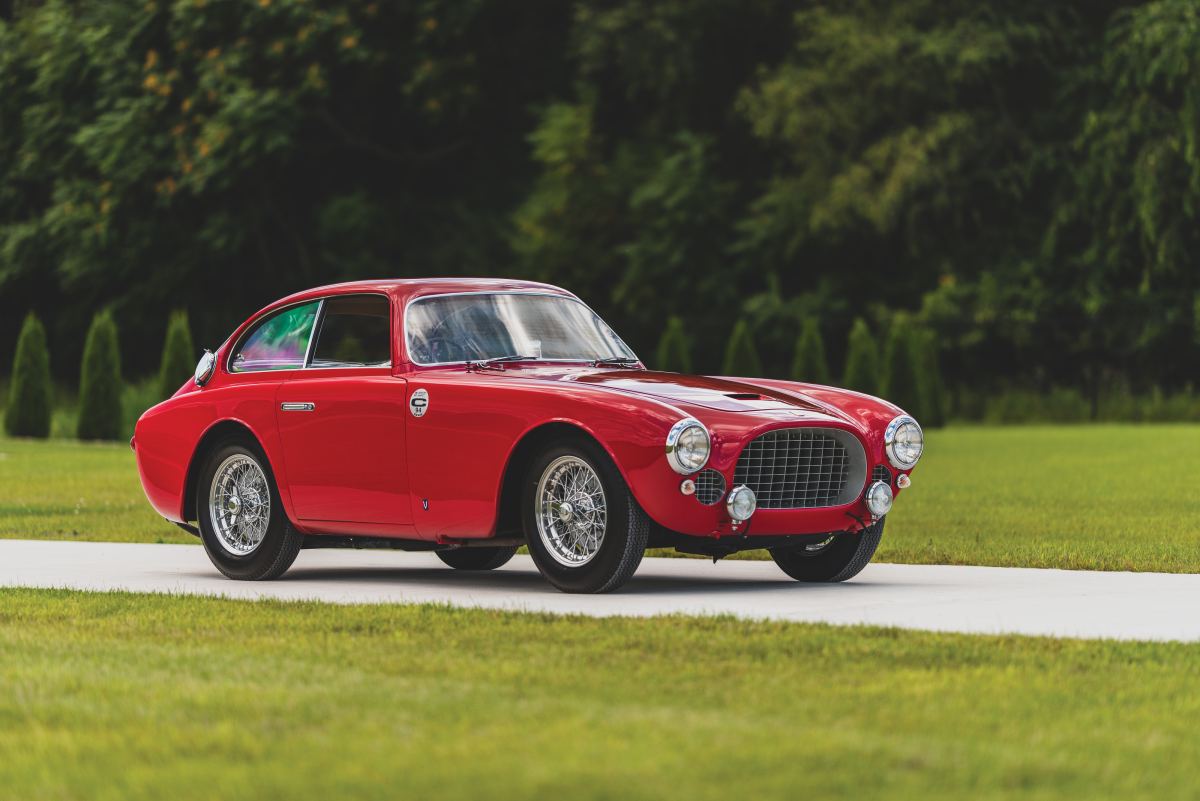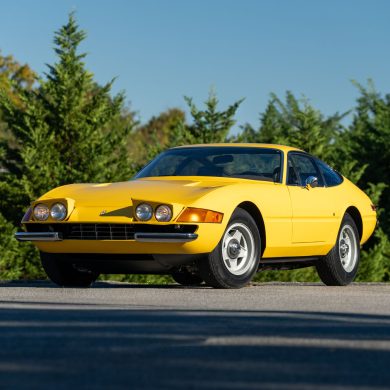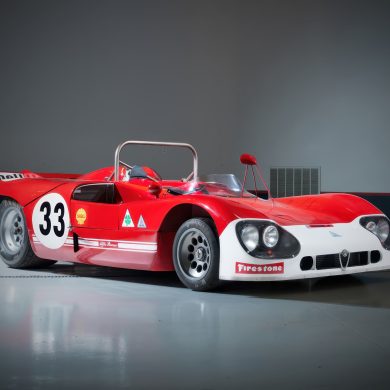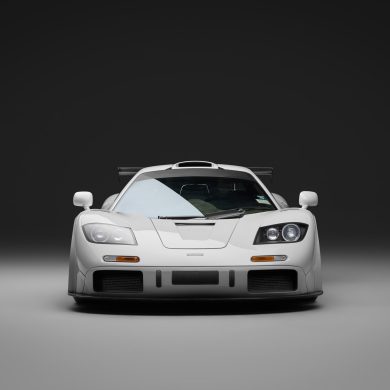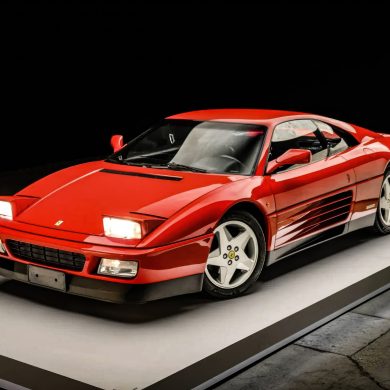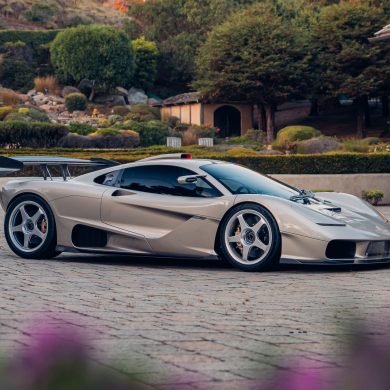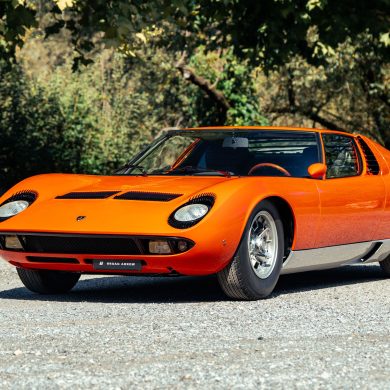On the weekend of October 23-24, RM Sotheby’s held a live auction of the outstanding Elkhart Collection. The auction, which was held in Elkhart, Indiana featured more than 240 highly collectible cars, as well as a number of memorabilia that were offered almost entirely without reserve and grossed an impressive $44,385,420 in sales.
The two-day auction was made on behalf of trustees of U.S. Bankruptcy Court, and it was a lively event with bids coming in from both the auction room and the 2,500 bidders that joined remotely from 53 countries. RM Sotheby’s has revealed that around fifty-five percent of the bidders were new clientele.
“We are extremely pleased with the results, especially considering the complexities and challenges of executing such a high-profile auction with multiple constituents in the current market environment. I believe this auction highlighted RM Sotheby’s key strengths and capabilities as a global market leader for achieving successful results for private collections. The Elkhart Collection auction was also another case study for the power of ‘no reserve’ collection auctions, with many of the lots seeing incredible results. The success of The Elkhart Collection auction joins previous court-authorized bankruptcy auctions that RM Sotheby’s has successfully conducted such as the 2016 Duemila Route sale in Milan, Italy on behalf of the Italian Government and the 2017 Level 5 Motorsports liquidation in Auburn, Indiana on behalf of U.S. Federal authorities, and further highlighting our company’s ability to execute complex sales successfully on a global scale.”
RM Sotheby’s President and CEO, Kenneth Ahn.
During the two-day auction, the items were able to sell for great prices, with eight motor cars even selling for more than $1,000,000. The main highlight of the event was the rare and elegantly finished 1952 Ferrari 225 S Berlinetta by Vignale which sold for $2,810,000 during the Saturday sale event.
Another beautifully rare competition car that was in the top five sale was the 1955 Cooper-Jaguar T38 MK II that sold for $1,765,000.
After the auction, RM Sotheby’s Car Specialist Donnie Gould happily shared:
“We could not be more thrilled with the success of The Elkhart Collection auction. I am grateful to the consignors for entrusting us to offer this meticulously curated, high quality collection of cars and memorabilia. This was a truly unique collection representing exceptional quality, and we had nearly 75 percent of bidders participating over the phone or internet placing thousands of bids, with more than half of all bidders new to our company.? I am proud of how our team members globally executed this sale flawlessly. Overall, the results were exceptional proving that the market for high quality collector cars is alive and well across all price points.”
The top three sales at the RM Sotheby’s 2020 ‘Elkhart Collection’ Auction were the 1952 Ferrari 225 S Berlinetta by Vignale, the 1953 Fiat 8V Supersonic by Ghia, and the 1957 Jaguar XKSS Continuation. Further details of each car can be found below.
1952 Ferrari 225 S Berlinetta by Vignale
Sale Price: $2,810,000
It was in the early part of 1952 when Ferrari decided to improve on the short-block Colombo-designed V-12 engine by increasing each cylinder to 225cc to have a total displacement of around 2.7 liters. The 225 Sport model that was made was an improved version of the 212 Export’s chassis that used the same 2,250mm wheelbase. There were only around 21 examples that were produced in both open and closed configurations.



Similar to the Export, the 225 S was designed to be a high-performing vehicle that is capable of entering competitions, so cars were given even-numbered chassis numbers and equipped with right-hand drive and triple Weber carburetors.
Almost all the models made were bodied by the coachbuilding that became Maranello’s main choice for the Lampredi-engined competition cars, Vignale. In 1952, it was extensively campaigned in Europe and was also later campaigned in SCCA events.
The 225 S was driven by some of the greatest drivers including Giovanni Bracco, Piero Taruffi, Eugenio Catellotti, Roy Salvadori, and Jim Kimberly. It won in the 1952 Monaco Grand Prix, Coppa d’Oro di Sicilia, Bari Grand Prix, Coppa d’Oro delle Dolomiti, and Coppa dela Toscana.

The beautifully finished and exceeding rare 225 S has been used for period competitions and more recently, for premium event participation. Chassis no. 0164 ED is the second of only six closed cars, and around the fifth of all the 21 examples built.
The example has an original finish in rosso with a beige leather interior. The 0164 ED was unique in that it did not have the usual fender portholes, though in place of the fender portholes were secondary engine vents that were placed under the headlamps. It also had an outside fuel-filler cap on the C-pillar on the driver’s side which fed through the rear shelf.


In the early 1952, it was sold new to Franco Bordoni-Bisleri, an Italian privateer and former ace fighter pilot. He immediately entered it in the XII Giro di Sicilia around April wearing #403. Along with Bordoni, he also had Olympian bobsledder Alberto Della Beffa driving and they were able to get an overall sixth finish, as well as fourth in Class.
The month after, Bordoni and a Mr. Geronimo led the car to finish tenth overall, and get a second in-Class finish during the Mille Miglia. Soon after, it was sold to Kleber-Colombes, a Parisian tire company that had recently introduced the first tubeless tire to the market. The Berlinetta was promptly repainted in French blue and had Jean Lucas behind the wheel during competitions.
At the 12 Hours of Casablanca, Lucas and Jacques Peron drove it to a second overall finish by May 1952 and just a week after that, they were able to get fourth overall at the Monaco Grand Prix. By June and July of the same year, the Berlinetta won at the Grand Prix d’Orleans, Grand Prix de Bressuire, and Les Sables d’Olonne.

Lucas was also behind the wheel of the 225 S at the Roubaix Grand Prix in September 1952 in France, but it had an early retirement. Period photos showed that Chassis 0164 ED was sent to the Ferrari factory for body repairs for the damages it got during a rollover crash. Since the car still had its race #441 when it was sent for repairs, it was assumed that the DNF that it had at the Roubiax was due to an accident during the race.
The repairs made gave the car one of its most distinguishing characteristics, as a small cooling vent around the front of the hood was added.
It was not long before Lucas was back behind the wheels as he finished fourth overall finish at the Circuit de Vitesse d’Agadir by February 1953 in Morocco. The following month, Lucas had his final race in the 225 S at the Circuit de Nimes and he finished third overall.
In 1954, Luigi Chinetti Motors sold the example to an Ohio enthusiast, Robert Tappan. The Berlinetta was entered in at least one SCCA race, but there was no result recorded during the Akron Airport event in the same year.
The 225 S was eventually sold to Alfred Momo, a New York City dealer and tuner, late in the decade. Before the end of the 1950s, two more enthusiasts took ownership of the Berlinetta, Mr. Trooter and John Levitt.

In 1959, Eugene Aucott of Philadelphia took ownership, and it was also around this time that car had a second engine modification to a bigger displacement of 3.0 liters. He held onto the Ferrari for at least four years and he presented the 225 S at the New Hope Auto Show in Pennsylvania in August 1963.

It was in 2012 that the 225 S was acquired by the current owner and the Berlinetta was used in a few celebratory events like the three appearances that it had during the Monaco Historic Grand Prix in 2012, 2014, and in 2016. It was also in 2013 and 2014 that the Ferrari entered the Mille Miglia Storica, and in 2015 it entered the Lavant Cup at the Goodwood Revival. In August 2017, it was invited to and was presented at the Pebble Beach Concours d’Elegance.
As for improvements In performance and safety in vintage events, the Ferrari was fitted with a Tremec five-speed gearbox making sure that its original numbers matching unit are preserved on the side. Automotive Unlimited in Warsaw, Indiana, gave it its beautiful finish with the interior finished in proper beige leather, as well as reupholstering the racing seats.

1953 Fiat 8V Supersonic by Ghia
In 1952, Road & Track described the most legendary and significant production model from Fiat, the 8V Supersonic, as ‘the biggest surprise of the year.’


In the early twentieth century, Fiat was known for competition cars that were both massive and magnificent, although, after World War II, the company became known for its mass-produced automobiles that catered to the common man. Their cars, like the tiny “Topolino,” was one of their most popular models in Europe and they were considered to have put a whole nation on wheels.
So when Fiat decided to introduce the powerful sports car that had an advanced overhead-valve light-alloy V-8 engine, Siata-fabricated chassis, four-wheel independent suspension, and it had the capability to be raced by privateers all over the world, it shocked the automotive world.
As was typical of the most advanced chassis of the time, the 8V was fitted with custom coachwork. Carrozzeria Ghia of Torino made around 30 to 40 of the 114 chassis built for the 8V, and 15 of which were considered to be the most striking due to Giovanni Savonuzzi’s impressive Jet Age design that was simply known as the “Supersonic.”

The Supersonic design was originally made for an Alfa Romeo racing car, and Savonuzzi designed it with a steeply raked, long windshield and a curved nose that created a straight-through beltline, finishing it with small tail fins flaring off lights that were supposed to look like jet afterburners, and a low, glassy greenhouse.
American designer Paul Farago requested a similar style on the 8V chassis, and it wasn’t long before 14 more examples were ordered. There are slight detail differences, but the examples stayed true to Savonuzzi’s original and striking design. They were considered to be the most desirable 8Vs having the best combination of avant-garde design from the Jet Age. Even today, the dramatic and stunningly modern cars continue to turn heads and there are very few cars that can stop concours crowds like the 8V.

Mr. Henry de Segur Lauve, a General Motors designer who was the concept artist attributed with the original Corvette prototype as well as other significant cars, was present at the official debut of the Supersonic at the 1953 Paris Auto Show. The style of the new model captured Lauve’s interest and he immediately placed an order for himself, which he requested to be finished in white with blue interior and was subsequently shipped from the Genoa docks aboard the SS Constitution.
Like the normal 8Vs at the time, it had exquisite hardware and the interior featured an elaborate Ghia-badged speedometer behind the wood-rimmed steering wheel.


Roughly a year later, Mr. Lauve contacted Fiat complaining that he was having difficulties with the engine of his car in his everyday use. Tony Adriaensen’s book Otto Vu, noted the amusing response that Lauve received from the Italian automaker as they were surprised he was using the example as a ‘daily driver’ especially since it was intended to be used by wealthy amateur racing drivers.
Still, Fiat agreed to fit it with a new engine (no. 000188) as well as its ancillary components as long as Mr. Lauve returned the original engine (no. 000039). It is interesting to note that the engine was never returned to Fiat and was placed in another 8V Supersonic.

Before the new engine was installed, Mr. Lauve used a Chevrolet 282 V-8 engine as recalled by another GM designer, Robert Cumberford. It was also around this time that the car’s flanks treatment was appropriated for the new 1958 Chevrolet, showing the attention that Mr. Lauve and his fellow designers gave the car.

After 1994 the car was restored in rich garnet-over-tan combination, and again, a correct 8V engine (no. 000060) was placed under the hood. The detail showed off the elaborate curves of the Supersonic body and finished it with glorious touches like smoked glass sun visors and Borrani chrome wire wheels.
After being part of a well-known Swiss collection, the car was then transferred to the current collection and has been well maintained since along with other superlative 8Vs.
1957 Jaguar XKSS Continuation
There are only a handful of modern sports cars whose legend exceeds that of the Jaguar XKSS.


After the company took a step back from racing after the 1956 season, there were a few completed and incomplete D-Types unsold in the factory stock. The company decided to convert the cars to road-going specifications to eventually be sold to the American market.
Jaguar modified the bodywork by removing the divider between the seats as well as the large tail fin. They also added a passenger door, a full-width windshield with chromed frame, chromed bumperettes, side screens in the driver and passenger doors, and a simple folding top. Still, the XKSS remained to be a D-Type that was slightly contained and tamed.

It is rare that a race car with a few minor modifications was sold as a road car, and it was not a surprise that most of the people who ended up buying the XKSS were sportsmen who decided to race the cars anyway. The famous “Flying Dentist” Dick Thompson is one of them.
Despite wealth and status, not everyone was able to get their hands on the XKSS. After sixteen D-Types were finished to XKSS specification, a fire swept through Jaguar’s Browns Lane factory destroying the remaining nine chassis. Since the company only wanted to make the model until the remaining D-Type stock were sold and used up, the fire simply meant that there were no more XKSS to be made.
The few that were left of the sixteen 1957 models are treasured and fiercely guarded by automobile collectors. The most famous of the examples is the one that was owned and regularly driven by American Actor Steve McQueen. The car has been linked to the fame of its owner, becoming a legend in itself.
Since the car was in such high demand, Jaguar announced in March 2016 that they will be completing the intended original production run of 25 cars by finally making the nine XKSS that were lost to the Browns Lane fire. Each of the nine cars will be made in the Jaguar Land Rover Classic facility, and as a fitting tribute, at Browns lane, which had previously released a run of the new E-Type Lightweight coupes, one of which is also part of the collection offered.

After eighteen months of research which includes digitally scanning a few original XKSS examples, an initial prototype was created for the nine production cars.
Each car is completely new, although it used one of the original nine chassis numbers that were assigned to the cars that were burned in 1957.
Traditional construction methods were used, which includes hand-wheeling the bodies over a styling buck and bronze-welding the frame. The riveted two-piece magnesium alloy wheels, aircraft-inspired, Le Mans tested four-wheel Dunlop disc brakes, and Dunlop tires are all period-correct fitments.
Each of the nine engines was cast to original specifications, which includes new blocks and cylinder heads, as well as three Weber DC03 carburetors. The Smiths instruments, dashboard knobs, and the grain of the leather upholstery are as-original showing the passion and determination of Jaguar to ‘do it right, or not at all.’
There were only very minor changes that were done, and always to the improvement and safety of the driver and passenger, like installing a modern fuel cell. Compared to the 1950s units, the seats a little bit larger and more comfortable. It is not a surprise that upon introduction, the nine XKSS produced in 2017 were immediately sold out. Like the sixteen that were originally built in 1957, these units are very rarely offered for sale by the owners.


The offering of this example might actually be the first time that this model was offered for public auction, so the new owner is extremely lucky to get their hands on the example.


The example has been in the collection since new and from the time of cataloging has only recorded 51 miles. The XKSS, like the Ferrari 250 GTO, and the McLaren F1, is the pinnacle of post-war sports cars.
Top 10 Sales at RM Sotheby’s 2020 ‘Elkhart Collection’ Auction:
1. Ferrari 225 S Berlinetta by Vignale $2,810,000.00
2. Fiat 8V Supersonic by Ghia $2,040,000.00
3. Jaguar XKSS Continuation $1,985,000.00
4. Cooper-Jaguar T38 Mk II $1,765,000.00
5. Jaguar E-Type Lightweight Continuation $1,710,000.00
6. Mercedes-Benz 300 SL Gullwing $1,495,500.00
7. Jaguar D-Type Continuation $1,325,000.00
8.Lot 22421969 Lamborghini Miura P400 S by Bertone $1,160,000.00
9.Lot 22151967 Toyota 2000GT $912,500.00
10.Lot 22381954 Fiat 8V Coupe by Vignale $907,000.00
For complete auction results, please visit RM Sotheby’s.
[Source: RM Sotheby’s]


